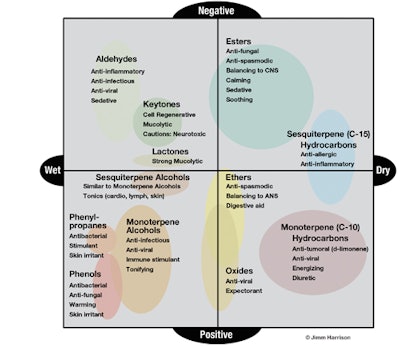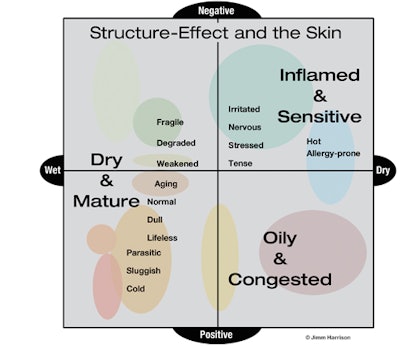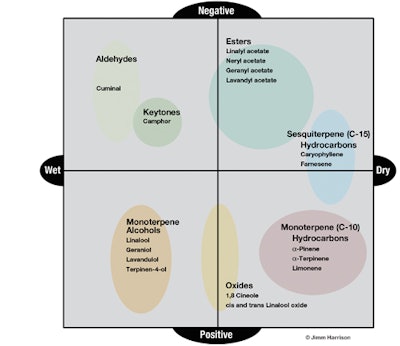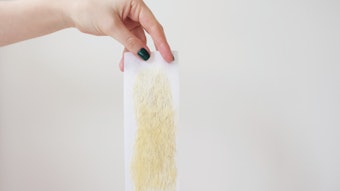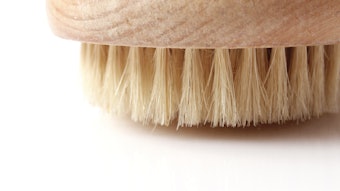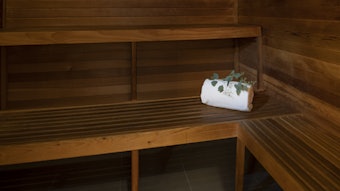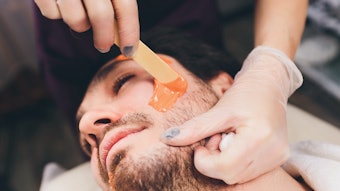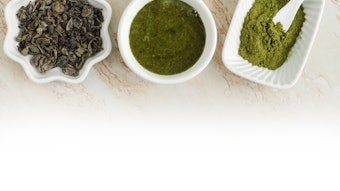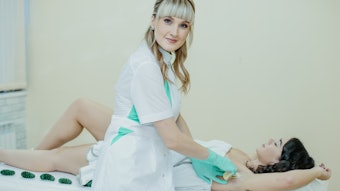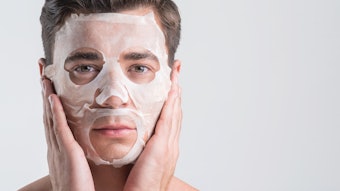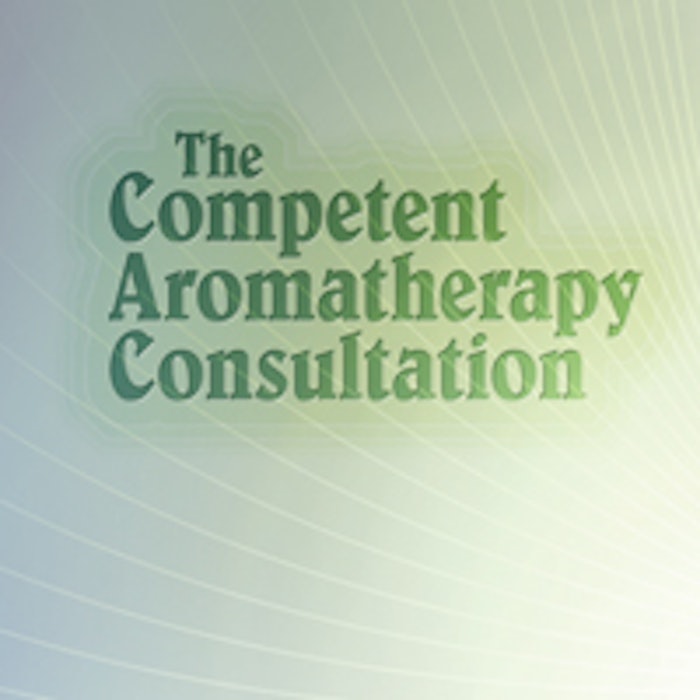
The successful use and application of essential oils, known as aromatherapy, is easily accomplished and requires very little knowledge. There are a few rules, the first one being, purchase some oils and use them. From this humble beginning, steps can be taken to make your essential oil treatments more effective and finely tuned for precise activity and healing results. Familiarity with the oils used, application methods, formulation, and a study of essential oil chemistry and biology are building blocks to achieving your clients’ desired outcomes. Like any successful treatment, you begin with a well-defined purpose, or therapeutic goal, for the use of the oils. This is accomplished with a competent holistically focused aromatherapy consultation.
Aromatherapy treatments can be thought of like a well-structured business plan and should include the following treatment progression.
- Identify the client’s therapeutic goal.
- Find out what essential oil properties would best achieve the goal.
- Find out what chemical compounds contain the selected properties.
- Compose a list of essential oils with the desired properties and compounds.
- Figure out what application is best suited to the desired goal.
- Make a final selection of oils for blending.
- Blend according to the therapeutic goal, application method and fragrance.
Your competent aromatherapy consultation is your guide to defining a goal, selecting an essential oil, and applying and blending it for your treatment plan. The information needed for such a consultation, resulting in customized experiences for consumers with therapeutic goals, as well as increased retail sales, is included in this article.
Art, science and skill
Essential oils are richly diverse therapeutic tools that bring together art and medical science. They are mysterious in many ways, not always abiding by modern scientific research, and can be found to have contradictory and conflicting results when analyzed and studied. The science of essential oils is complicated, making aromatherapy a scientifically sound practice that requires intuitive and artful expertise.
For many aromatherapists, this artistic side is the heart and soul of this practice. And, as in any creative and intuitive art, it’s fun. When your intuitive and creative practice includes a foundation of experience and a solid scientific understanding of essential oils, your skill as a spa professional is amplified. A perceptive and finely tuned aromatherapy consultation is another aspect to your art and proficiency as a spa professional.
The chemistry of essential oils
The properties derived from essential oils are a result of their chemical structure. A working knowledge of the chemical compounds, their molecular groupings and their properties is necessary to increase your abilities as an aromatherapist and is employed in a competent aromatherapy consultation.
The Structure-Effect Diagram, as seen in the figures posted to the right of this text, charts the compounds according to their electropositive and electronegative charges, and their polarity, which relates to the essential oil compound’s affinity with water. The charge and polarity of the individual compounds create a guide to the therapeutic properties associated with the compounds and the oils that contain them. Figure 1 shows the properties of the molecular family groupings, and Figure 2 places symptoms and conditions related to skin over the area—or molecular groupings—most suited to treating the conditions. The families and some of the compounds found in lavender are shown in Figure 3.
The molecular family groupings are situated on the chart, giving a visual presentation of the properties associated with them. The more electronegative the molecule, the more calming it is; electropositive compounds are stimulating. The polarity of the molecule is referred to as the wet and dry tendency of the compound. This simplistic definition of the Structure-Effect Diagram only hints to its potential as a valuable means to the successful and accurate use of essential oils. When used with a competent consultation, your selection and choice of essential oils will become finely tuned, making the most of the oils’ multifunctional capabilities.
From symptoms to the big picture
Your competent aromatherapy consultation will take you from symptom management to bringing balance to your client’s whole system. This approach defines holistic therapy. Because the essential oils are multifunctional remedies, they will, by their nature, provide treatment beyond symptom management. The beauty in this is that you will address potential imbalances and the causes of symptoms of which you may not have been aware. During your consultation, you will be focused on the big picture, the holistic model. Environment, diet, lifestyle and emotional state are just the starting points of a thorough consultation.
The holistic consultation
A holistic consultation can be expansive and designed to address every “why” that relates to a symptom. Commonly overlooked areas of a consultation form may provide clues to understanding why there is, for example, an acneic condition that may be related to inflammation caused by stress. In this situation, your expertise and study of essential oils leads you to choose cedarwood, and its compound, cedrol, for autonomic system balance, as well as frankincense, with sesquiterpene hydrocarbons, for inflammation. The complex chemical structure of both oils addresses many other symptoms and skin conditioning related to skin eruptions, as well.
A competent aromatherapy consultation drives deep into who the clients are, what they think, eat, feel, do and so much more. For instance, a deeper question to ask when you see clients have checked “fish” as a regular food in their diet is “Do you eat farmed fish or fish known to have high mercury levels?” This question will inform a knowledgeable spa professional to potential allergies, antibiotic contamination and potential toxicity related to high mercury levels, all of which may appear as imbalance and disease.
Following are some categories that should be included in a thorough holistic evaluation.
Personal information
Medical profile
Diet
Lifestyle
Habits, feelings and relationships
Exercise and physical activity
History of alternative and natural therapies
Skin analysis
Each category should have a long list of questions and pertinent information. In many instances, the questions asked, such as those that would be asked under habits, feelings and relationships, are extremely personal and may not be appropriate. Answers to these questions often can be garnered from casual conversations with the client, during which you will obtain a fair amount of your most helpful insight. As you become more experienced in your consultation skills, you will begin to recognize the information worthy of recording that may factor into treatment with essential oils.
Client analysis
Combining these examples—a stressed client who eats farmed fish and is experiencing serious skin eruptions—you may formulate your remedy using the already-mentioned cedarwood and frankincense with tea tree to address the antimicrobial infection, as well as potential imbalances caused by the antibiotics eaten in the farmed fish. Mercury toxicity is a more complicated and involved condition and, from an herbal standpoint, chelating herbals and other plant supplements are generally recommended and essential oils, such as helichrysum, rosemary and lavender, may potentially assist the body in detoxification. If there is evidence of mercury toxicity being an issue, or if any condition appears to have medical implications, you should recommend that clients consult their physicians immediately.
A stressed condition with headache and skin sensitivity may be the result of several factors. An anxious person would benefit from neroli, with anxiety-soothing ester compounds. If the sensitivity and headache are a result of a digestive imbalance, the selection of oils may include ginger (sesquiterpene alcohols), rosemary and peppermint (monoterpene alcohols) or, in the case of imbalance of the autonomic nervous system, someone driven by the fight or flight response, the appropriate oils could be cedarwood (cedrol), anise seed or tarragon (balancing ethers). Your competent aromatherapy consultation is designed to decipher an accurate cause of symptoms and indicate a selection of oils that best matches the person, their habits and their environment.
Intuitive choices
Pay attention. As you stay open and alert and become more intuitive, you will discover every person, every consultation, has nuances, differences and similarities. So just in being alert, your intuition will trigger those issues or words that have value and may direct your essential oil choices.
Jimm Harrison is a master aromatherapist with more than 25 years of experience in the beauty industry. He is an author and educator, teaching holistic beauty and aromatherapy certificate courses at esthetic and massage institutions, and at Bastyr University school of natural medicine in Kenmore, WA. Harrison has developed organic spa products and consults on the use of natural ingredients and essential oils for healthy aging and skin care.
